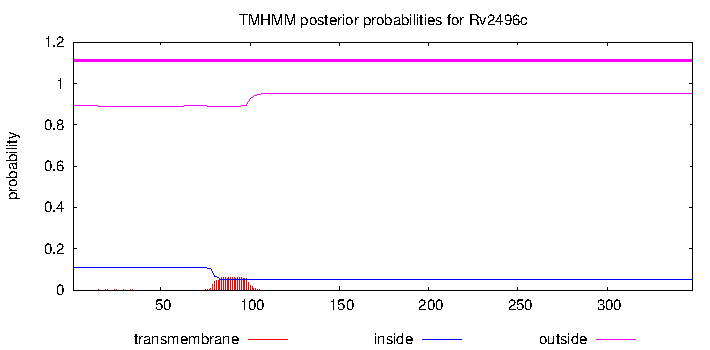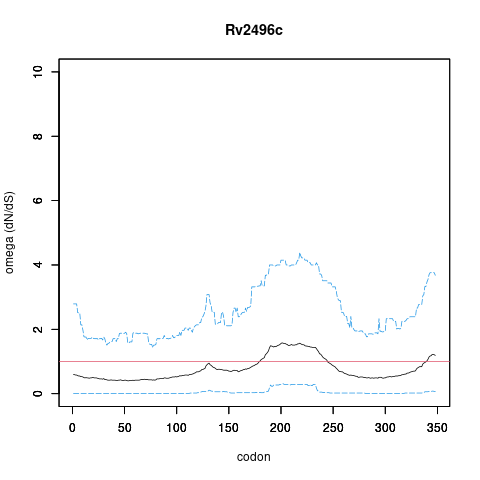Rv2496c (bkdB)
Current annotations:
TBCAP: (community-based annotations - see table at bottom of page )
TBDB: pyruvate dehydrogenase E1 component subunit beta
REFSEQ: pyruvate dehydrogenase E1 component beta subunit PdhB
PATRIC: Branched-chain alpha-keto acid dehydrogenase E1 component beta subunit (EC 1.2.4.4)
TUBERCULIST: Probable branched-chain keto acid dehydrogenase E1 component beta subunit BkdB
NCBI: Probable branched-chain keto acid dehydrogenase E1 component, beta subunit BkdB
updated information (H37Rv4):
gene name: bkdB
function:
reference:
Type: Not Target
Start: 2809936
End: 2810982
Operon:
Trans-membrane region:
Role: I.B.2 - Pyruvate dehydrogenase
GO terms:
Reaction(s) (based on iSM810 metabolic model):
Gene Expression Profile Gene Modules Orthologs among selected mycobacteria Protein structure:
Search for Homologs in PDB Top 10 Homologs in PDB (as of Nov 2020): PDB aa ident species PDB title 1UMD 48% Thermus thermophilus branched-chain 2-oxo acid dehydrogenase (E1) from Thermus thermophilus HB8 with 4-methyl-2-oxopentanoate as an intermediate 1UMC 48% Thermus thermophilus branched-chain 2-oxo acid dehydrogenase (E1) from Thermus thermophilus HB8 with 4-methylpentanoate 1UMB 48% Thermus thermophilus branched-chain 2-oxo acid dehydrogenase (E1) from Thermus thermophilus HB8 in holo-form 1UM9 48% Thermus thermophilus branched-chain 2-oxo acid dehydrogenase (E1) from Thermus thermophilus HB8 in apo-form 3DVA 47% Bacillus stearothermophilus Snapshots of catalysis in the E1 subunit of the pyruvate dehydrogenase multi-enzyme complex 3DV0 47% Bacillus stearothermophilus Snapshots of catalysis in the E1 subunit of the pyruvate dehydrogenase multi-enzyme complex 3DUF 47% Bacillus stearothermophilus Snapshots of catalysis in the E1 subunit of the pyruvate dehydrogenase multi-enzyme complex 1W88 47% GEOBACILLUS STEAROTHERMOPHILUS The crystal structure of pyruvate dehydrogenase E1(D180N,E183Q) bound to the peripheral subunit binding domain of E2 1W85 47% GEOBACILLUS STEAROTHERMOPHILUS The crystal structure of pyruvate dehydrogenase E1 bound to the peripheral subunit binding domain of E2 2BP7 43% PSEUDOMONAS PUTIDA New crystal form of the Pseudomonas putida branched-chain dehydrogenase (E1)
Links to additional information on bkdB:
Amino Acid Sequence
MTQIADRPARPDETLAVAVSDITQSLTMVQAINRALYDAMAADERVLVFGEDVAVEGGVFRVTEGLADTFGADRCFDTPLAESAIIGIAVGLALRGFVPV
PEIQFDGFSYPAFDQVVSHLAKYRTRTRGEVDMPVTVRIPSFGGIGAAEHHSDSTESYWVHTAGLKVVVPSTPGDAYWLLRHAIACPDPVMYLEPKRRYH
GRGMVDTSRPEPPIGHAMVRRSGTDVTVVTYGNLVSTALSSADTAEQQHDWSLEVIDLRSLAPLDFDTIAASIQRTGRCVVMHEGPRSLGYGAGLAARIQ
EEMFYQLEAPVLRACGFDTPYPPARLEKLWLPGPDRLLDCVERVLRQP
(
Nucleotide sequence available on
KEGG )
Additional Information
Analysis of Positive Selection in Clinical Isolates
*new*
Analysis of dN/dS (omega) in two collections of Mtb clinical isolates using GenomegaMap (Window model) (see description of methods )
Moldova: 2,057 clinical isolates
global set: 5,195 clinical isolates from 15 other countries
In the omega plots, the black line shows the mean estimate of omega (dN/dS) at each codon, and the blue lines are the bounds for the 95% credible interval (95%CI, from MCMC sampling).
A gene is under significant positive selection if the lower-bound of the 95%CI of omega (lower blue line) exceeds 1.0 at any codon.
Moldova (2,057) global set (5,195)
under significant positive selection? NO NO
omega peak height (95%CI lower bound) 1.57 (0.31) 1.14 (0.5)
codons under selection
omega plots
genetic variants* link link
statistics at each codon link link
* example format for variants: "D27 (GAC): D27H (CAC,11)" means "Asp27 (native codon GAC) mutated to His (codon CAC) in 11 isolates"
MtbTnDB - interactive tool for exploring a database of published TnSeq datasets for Mtb
TnSeqCorr
Rv2496c/bkdB,
gene len: 1046 bp, num TA sites: 24
condition dataset call medium method notes
in-vitro DeJesus 2017 mBio non-essential 7H9 HMM fully saturated, 14 TnSeq libraries combined
in-vitro Sassetti 2003 Mol Micro growth-defect 7H9 TRASH essential if hybridization ratio<0.2
in-vivo (mice) Sassetti 2003 PNAS non-essential BL6 mice TRASH essential if hybridization ratio<0.4, min over 4 timepoints (1-8 weeks)
in-vitro (glycerol) Griffin 2011 PPath uncertain M9 minimal+glycerol Gumbel 2 replicates; Padj<0.05
in-vitro (cholesterol) Griffin 2011 PPath uncertain M9 minimal+cholesterol Gumbel 3 replicates; Padj<0.05
differentially essential in cholesterol Griffin 2011 PPath NO (LFC=0.69) cholesterol vs glycerol resampling-SR YES if Padj<0.05, else not significant; LFC<0 means less insertions/more essential in cholesterol
in-vitro Smith 2022 eLife non-essential 7H9 HMM 6 replicates (raw data in Subramaniam 2017, PMID 31752678)
in-vivo (mice) Smith 2022 eLife non-essential BL6 mice HMM 6 replicates (raw data in Subramaniam 2017, PMID 31752678)
differentially essential in mice Smith 2022 eLife NO (LFC=-0.282) in-vivo vs in-vitro ZINB YES if Padj<0.05, else not significant; LFC<0 means less insertions/more essential in mice
in-vitro (minimal) Minato 2019 mSys non-essential minimal medium HMM
in-vitro (YM rich medium) Minato 2019 mSys non-essential YM rich medium HMM 7H9 supplemented with ~20 metabolites (amino acids, cofactors)
differentially essential in YM rich medium Minato 2019 mSys NO (LFC=0.37) YM rich vs minimal medium resampling
TnSeq Data No data currently available.
No TnSeq data currently available for this Target.
RNASeq Data No data currently available.
No RNA-Seq data currently available for this Target.
Metabolomic Profiles No data currently available.
No Metabolomic data currently available for this Target.
Proteomic Data No data currently available.
No Proteomic data currently available for this Target.
Regulatory Relationships from Systems Biology
BioCyc
Gene interactions based on ChIPSeq and Transcription Factor Over-Expression (TFOE) (Systems Biology )
NOTE:
Green edges represent the connected genes being classified as differentially essential as a result of the middle gene being knocked out. These interactions are inferred based on RNASeq.
Interactions based on ChIPSeq data
RNA processing and modification
Energy production and conversion
Chromatin structure and dynamics
Amino acid transport and metabolism
Cell cycle control, cell division, chromosome partitioning
Carbohydrate transport and metabolism
Nucleotide transport and metabolism
Lipid transport and metabolism
Coenzyme transport and metabolism
Translation, ribosomal structure and biogenesis
Cell wall/membrane/envelope biogenesis
Replication, recombination and repair
Posttranslational modification, protein turnover, chaperones
Secondary metabolites biosynthesis, transport and catabolism
Inorganic ion transport and metabolism
General function prediction only
Intracellular trafficking, secretion, and vesicular transport
Signal transduction mechanisms
Differentially expressed as result of RNASeq in glycerol environment (Only top 20 genes shown sorted by log fold change with p_adj 0.05).
Conditionally essential as result of TNSeq (Only top 20 genes shown sorted by log fold change with p_adj 0.05).
Binds To:
No bindings to other targets were found.
Bound By:
No bindings from other targets were found.
Binds To:
No bindings to other targets were found.
Bound By:
Upregulates:
Does not upregulate other genes.
Upregulated by:
Not upregulated by other genes.
Downregulates:
Does not downregulate other genes.
Downregulated by:
Not downregulated by other genes.
Property Value Creator Evidence PMID Comment
Interaction Operon Rv2497c akankshajain.21 IEP CoexpressionJ. Tian, R. Bryk et al. Mycobacterium tuberculosis appears to lack alpha-ketoglutarate dehydrogenase and encodes pyruvate dehydrogenase in widely separated genes. Mol. Microbiol. 2005
Interaction Operon Rv2495c akankshajain.21 IEP CoexpressionJ. Tian, R. Bryk et al. Mycobacterium tuberculosis appears to lack alpha-ketoglutarate dehydrogenase and encodes pyruvate dehydrogenase in widely separated genes. Mol. Microbiol. 2005
Citation Mycobacterium tuberculosis appears to lack alpha-ketoglutarate dehydrogenase and encodes pyruvate dehydrogenase in widely separated genes. J. Tian, R. Bryk et al. Mol. Microbiol. 2005 akankshajain.21 IEP 16045627 Coexpression
Interaction Operon Rv2495c akankshajain.21 IEP CoexpressionJ. Tian, R. Bryk et al. Mycobacterium tuberculosis appears to lack alpha-ketoglutarate dehydrogenase and encodes pyruvate dehydrogenase in widely separated genes. Mol. Microbiol. 2005
Interaction Operon Rv2497c akankshajain.21 IEP CoexpressionJ. Tian, R. Bryk et al. Mycobacterium tuberculosis appears to lack alpha-ketoglutarate dehydrogenase and encodes pyruvate dehydrogenase in widely separated genes. Mol. Microbiol. 2005
Interaction RegulatedBy Rv3286c yamir.moreno IEP Microarrays. mRNA levels of regulated element measured and compared between wild-type and trans-element mutation (knockout, over expression etc.) performed by using microarray (or macroarray) experiments..EP. Williams, JH. Lee et al. Mycobacterium tuberculosis SigF regulates genes encoding cell wall-associated proteins and directly regulates the transcriptional regulatory gene phoY1. J. Bacteriol. 2007
Term EC:1.2.4.1 Pyruvate dehydrogenase (acetyl-transferring). - NR extern:JZUCKER NR Inferred from mutant phenotypeauthors,A. Venugopal,R. Bryk,S. Shi,K. Rhee,P. Rath,D. Schnappinger,S. Ehrt,C. Nathan Virulence of Mycobacterium tuberculosis depends on lipoamide dehydrogenase, a member of three multienzyme complexes. Cell Host Microbe 2011
Citation Central carbon metabolism in Mycobacterium tuberculosis: an unexpected frontier. authors,KY. Rhee,LP. de Carvalho,R. Bryk,S. Ehrt,J. Marrero,SW. Park,D. Schnappinger,A. Venugopal,C. Nathan Trends Microbiol. 2011 extern:JZUCKER 21561773 Traceable author statement to experimental support
Term EC:1.2.4.4 3-methyl-2-oxobutanoate dehydrogenase (2-methylpropanoyl-transferring). - NR extern:JZUCKER NR Traceable author statement to experimental supportauthors,KY. Rhee,LP. de Carvalho,R. Bryk,S. Ehrt,J. Marrero,SW. Park,D. Schnappinger,A. Venugopal,C. Nathan Central carbon metabolism in Mycobacterium tuberculosis: an unexpected frontier. Trends Microbiol. 2011
Term EC:1.2.4.1 Pyruvate dehydrogenase (acetyl-transferring). - NR extern:JZUCKER NR Traceable author statement to experimental supportauthors,KY. Rhee,LP. de Carvalho,R. Bryk,S. Ehrt,J. Marrero,SW. Park,D. Schnappinger,A. Venugopal,C. Nathan Central carbon metabolism in Mycobacterium tuberculosis: an unexpected frontier. Trends Microbiol. 2011
Citation Virulence of Mycobacterium tuberculosis depends on lipoamide dehydrogenase, a member of three multienzyme complexes. authors,A. Venugopal,R. Bryk,S. Shi,K. Rhee,P. Rath,D. Schnappinger,S. Ehrt,C. Nathan Cell Host Microbe 2011 extern:JZUCKER 21238944 Inferred from mutant phenotype
Term EC:1.2.4.4 3-methyl-2-oxobutanoate dehydrogenase (2-methylpropanoyl-transferring). - NR extern:JZUCKER NR Inferred from mutant phenotypeauthors,A. Venugopal,R. Bryk,S. Shi,K. Rhee,P. Rath,D. Schnappinger,S. Ehrt,C. Nathan Virulence of Mycobacterium tuberculosis depends on lipoamide dehydrogenase, a member of three multienzyme complexes. Cell Host Microbe 2011


